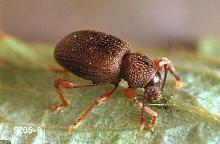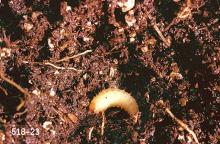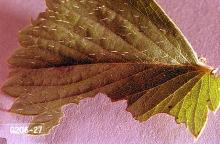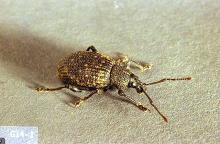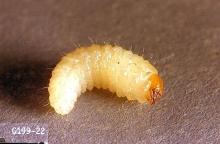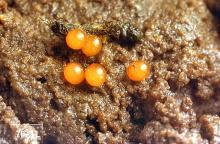Includes
Black vine weevil (Otiorhynchus sulcatus)
Rough strawberry root weevil (O. rugosostriatus)
Strawberry root weevil (O. ovatus)
Pest description and crop damage Black vine weevil (BVW) is probably the most common weevil to infest caneberry crops, but the strawberry root weevil (SRW) and rough strawberry root weevil (RSRW) are also pests. Adult weevils are 8-12 mm in length depending on the species. Adults are reddish brown to black; the BVW is larger and darker than the other species. Larvae of all species are quite similar in appearance and habits: they are C-shaped, legless, and white with tan heads, up to 12 mm in length. Adult weevil feeding causes a characteristic notching in the leaves of caneberries and other host plants. This feeding damage is relatively minor and causes little damage to the plants, but adults may contaminate fruit in mechanically harvested fields. The real damage is done by the larvae, which feed through the winter and spring on the root systems of host plants. Larvae feeding on roots can cause stunting and poor yields in young plants. With severe infestations, young plants may die.
Biology and life history Weevils overwinter as larvae in the soil. Feeding may occur throughout mild winters. In April-June, larvae pupate, and adult emergence occurs. Adults are night feeders that remain in the soil or in organic material at the base of the plant during the day, then climb up to feed on leaves at night. Adult weevils cannot fly, but walk or are carried from one location to another on plant material or equipment. Also, all adults are females capable of laying eggs. Adults are slow moving and should not be confused with swifter predacious ground beetles.
Eggs are laid in clusters in or on the soil from June to September. The eggs hatch and the larvae immediately wriggle through the soil to begin feeding. There is one generation per year.
Scouting and thresholds Inspect leaves for notching from adult feeding in early summer. Controls should be undertaken soon after adult feeding is observed, but before egg laying occurs, generally about four weeks. Presence of adults can be confirmed by night inspection of foliage on warm, still evenings. Or, look for adults in the day by looking through plant debris at the base of the plant. Wrapping the base of the plant with cardboard provides a refuge that can be checked easily in the early morning.
Management-biological control
- beneficial nematodes-Heterorhabditis spp. and Steinernema spp., have shown some effectiveness in controlling larvae when applied as label directs, as a drench in the fall. Nematodes must be placed in the root zone where weevil larvae are present.
See also:
Management-cultural control
Cultivating the soil in April-May before planting can eliminate overwintering larvae. Use a cereal cover crop, as small grains are not a host for root weevils.
Home gardeners: Hand-pick and destroy adults when found.
Management-chemical control: HOME USE
- bifenthrin
- carbaryl
- zeta-cypermethrin
Management-chemical control: COMMERCIAL USE
Apply chemical sprays at night, usually between dusk and midnight, on warm, calm evenings when adult weevils are on foliage and feeding. Control is usually poor when applied by day or on cold or windy nights.
- azadirachtin (Neemix, Aza-Direct, Ecozin Plus and other brands)-Consult label for rate. Some formulations are OMRI-listed for organic use.
- Beauveria bassiana (Mycotrol and other brands)-Consult label for rate. Some formulations are OMRI-listed for organic use.
- bifenthrin (Brigade and other brands) at 0.05 to 0.1 lb ai/A. PHI 3 days. Do not exceed 0.2 lb ai/A or two applications per crop season. Only one pre-bloom application of bifenthrin is allowed in caneberries: either soil-applied for raspberry crown borer control, or foliar-applied for root weevil or leafroller control, but not both. Restricted use pesticide.
- cyantraniliprole (Exirel) at 0.088 to 0.133 lb ai/A. PHI 1day. Adult weevil control only. Highly toxic to bees.
- esfenvalerate (Asana XL) at 0.05 lb ai/A. PHI 7 days. Label allows use for weevil control in Oregon and Washington only. Apply as a pre-bloom or post-bloom spray only. Remove bees prior to application. For maximum safety to bees, apply in the evening after sunset. Asana can act as a bee repellent; do not apply within 7 days of pollination. Because of pollinator hazard, WSU entomologists do not recommend its use on red raspberry. Restricted use pesticide.
- fenpropathrin (Danitol) at 0.2 to 0.3 lb ai/A. PHI 3 days. Restricted use pesticide.
- Isaria fumosorosea Apopka Strain 97 (Ancora)-Consult label for rate. OMRI-listed for organic use.
- malathion (several brands)-Check label for rate. PHI 1 day. EC formulations may cause phytotoxicity or leave an oily film on fruit if used during or near harvest.
- thiamethoxam (Actara) at 0.047 lb ai/A. PHI 3 days. Adult control. Do not apply during bloom or when bees are foraging in the area.
- zeta-cypermethrin (Mustang) at 0.05 lb ai/A. PHI 1 day. Restricted use pesticide.

